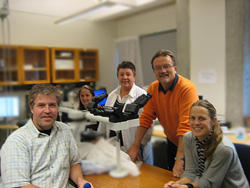Serendipitous observation leads to new directions in research
The Skeletal Development Group has a new name; Vertebrate evolution and development. According to Professors Sindre Grotmol, Harald Kryvi and Geir Låre Totland, the new name reflects an exciting evolution in the group's research activity towards more fundamental biological questions regarding the mechanism for the development of the vertebral column; the hallmark of the vertebrates.
Hovedinnhold
The group’s change in focus began with a serendipitous observation of the beginnings of segmentation of the cells of the notochord. Conventional dogma concerning the development of the vertebral column says that the segmentation process leading to the formation of vertebrae is a somitic cell phenomenon, and that the cells of the notochord were uninvolved in this process. However, researchers in the group were going through images from a routine visualization procedure when they noticed that a fortuitous tangential cut through a larval fish notochord revealed clusters of differentiating cells in a segmented repeat-pattern within the notochord.
Further results from scientists in the group have clearly documented that in teleost fish the formation of bone of the vertebra is initiated and segmentally arranged by cells in the notochord, and not via somitic cells, as conventional dogma states. Indeed, the group has shown that the notochord nucleates vertebral development, thus revealing a hitherto unknown segmentation process within the notochord that they have shown to play a central role in shaping the vertebrate embryo.
In addition to their break-through results, the work has involved the development of a number of new experimental methodologies within genetics and notochord organ culture aimed at identifying genes that control notochord segmentation.
“The past year has been a period of extensive lab work”, explains Professor Sindre Grotmol. “We will be analyzing this data and writing up results in the year to come.”
